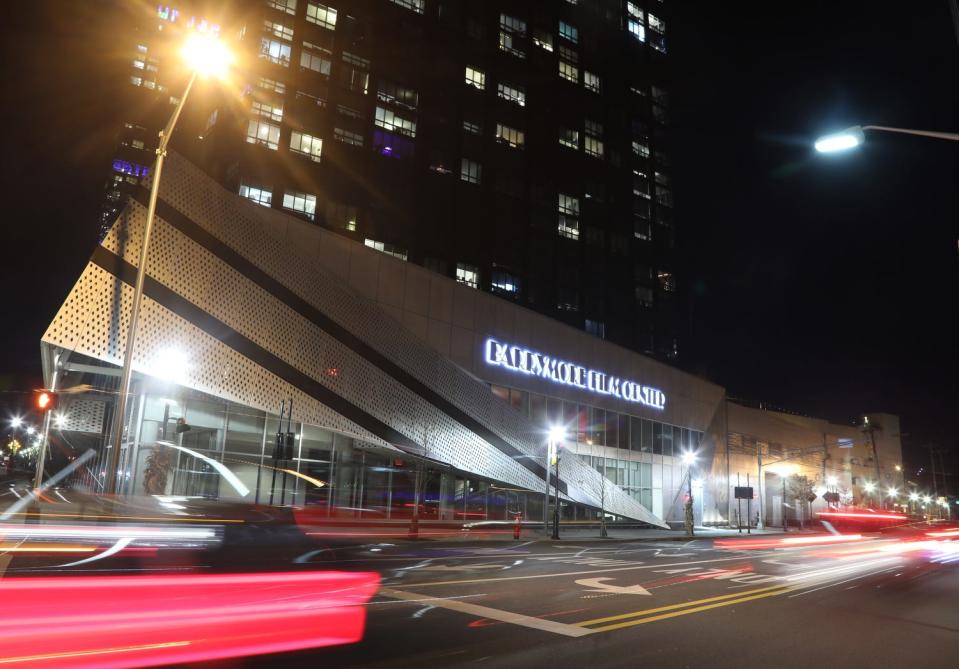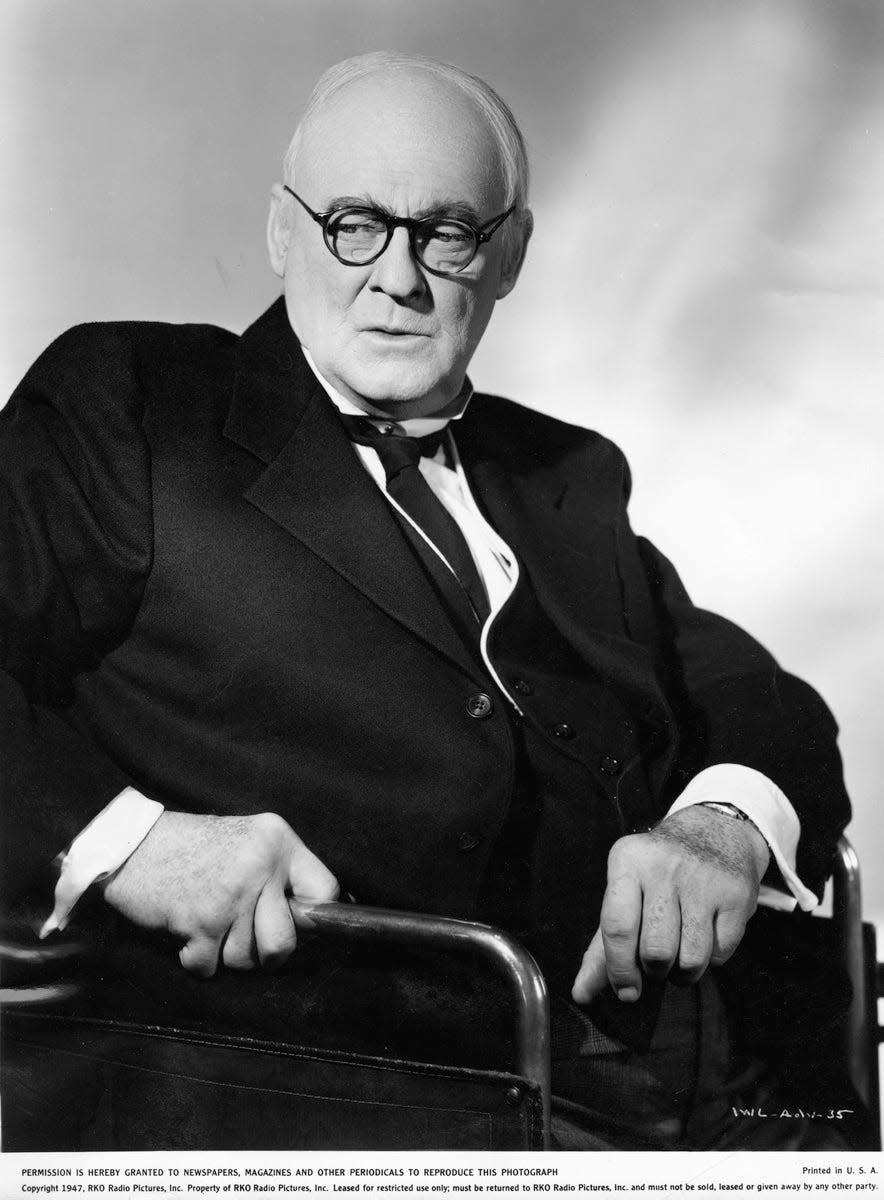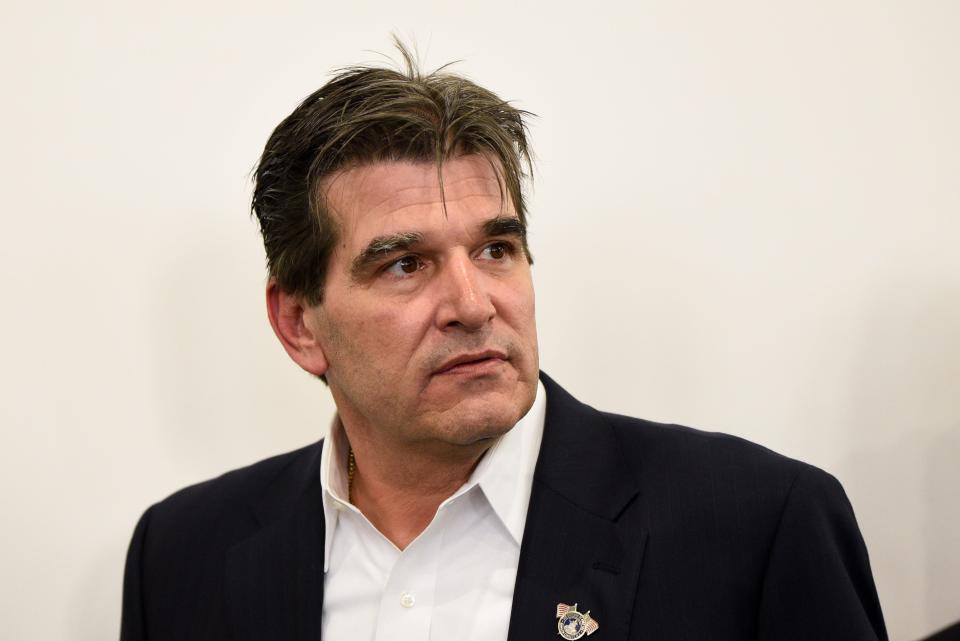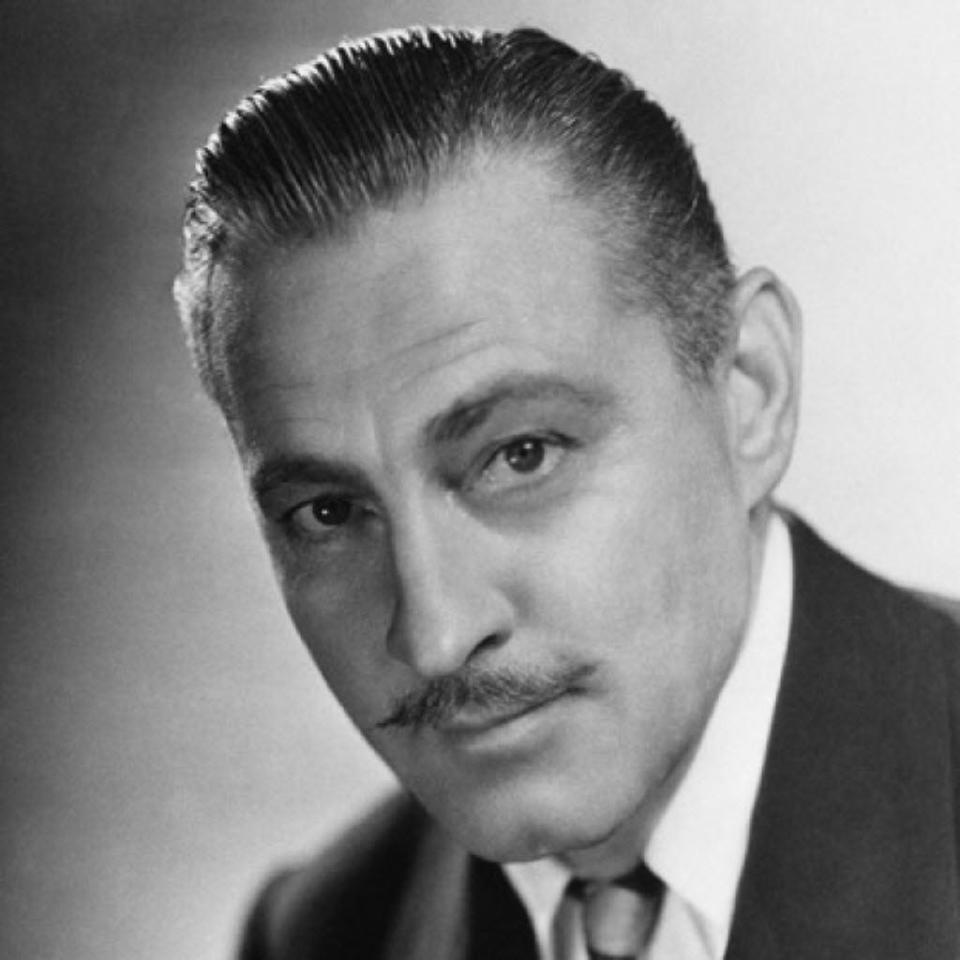In Fort Lee, a $16M film center opens, a shrine to the movies — and the Barrymores
- Oops!Something went wrong.Please try again later.
- Oops!Something went wrong.Please try again later.
- Oops!Something went wrong.Please try again later.
- Oops!Something went wrong.Please try again later.
- Oops!Something went wrong.Please try again later.
The new $16 million Barrymore Film Center in Fort Lee, finally opening Oct. 21 after two years of COVID-related delays, is a lot of things.
It's a museum. It's a 267-seat repertory film theater. It's a reception space. It's a tribute to Fort Lee's role, 120 years ago, as the birthplace of the movie industry.
It's also a monument — the greatest since Joyce Kilmer — to a tree.
The branching, forking family tree of America's greatest acting dynasty, the Barrymores, takes up an entire wall of the museum area. They, too, have roots in Fort Lee.

"When you look at that family tree, you realize how far back they go," said Mayor Mark J. Sokolich, who spearheaded the project along with some very knowledgeable film people.
"What made the Barrymores so amazing is that they were a theatrical family that made the jump to film," said Nelson Page, executive director of the new facility.
Famous family
You probably know Drew — star of "E.T. the Extra-Terrestrial" and "Ever After." Also maybe her grand-uncle, Lionel — who torments Jimmy Stewart every Christmas as mean Mr. Potter in "It's a Wonderful Life" (1946).
But bigger than either, in their day, were John Barrymore, "The Great Profile," the definitive Hamlet of his generation, and Ethel Barrymore, namesake of a theater on West 47th Street. They, and many other Barrymores, are celebrated in the exhibit "The Barrymores: The Royal Family of Fort Lee," at the museum space through April 30.
There are a lot of them. And they are genetically unmistakable.
"I had two guys delivering some equipment to the film center a few weeks ago," Page said. "I brought them around to a portrait of Ethel, and one guy said, 'Well, that's Drew Barrymore right there.' And I said, no, that's Ethel Barrymore — circa 1912.' They were stunned."
The Barrymore Center is about much more than this extraordinary family — though they'll be highlighted in the coming weeks.
The center opens to the public the weekend of Oct. 21 with a Barrymore six-pack. On Friday, Oct. 21, you can see John in "Twentieth Century" (1934; 7:15 p.m.) and "Counsellor at Law" (1933; 9:15 p.m.). On Saturday there's "Don Juan" (1926; 1 p.m.), "A Free Soul" (1931; 4:15 p.m. — this one stars John's brother Lionel) and "Dr. Jekyll and Mr. Hyde" (1920; 7:30 p.m.).
These films will be shown in the center's state-of-the-art auditorium — whose scalloped, Deco-ish ceiling, designed by architect Daria Pizzetta, is a nod to both Radio City Music Hall and the retro-futurist designs of William Cameron Menzies, the visionary behind the 1936 sci-fi classic "Things to Come." This is a theater for movie people, by movie people.
"We wanted something that had the feel of the future, with a tip of the hat to the past," Page said.
Preview:Here are North Jersey's most anticipated restaurant openings for fall 2022
Sandwiches:Corned beef, lobster rolls, po boys and more: These are North Jersey's 14 best
Eats:Four-star sushi, fried chicken,'OMG' pies: 12 new restaurants to try in North Jersey
Fully equipped
Three projectors will enable the Barrymore to screen virtually any format: 4K digital for the latest blockbuster; 35 mm and 70 mm projectors for vintage films that aren't available any other way.
An orchestra pit — perhaps the first designed for a movie theater since the 1920s — can accommodate up to 20 musicians for revivals of silent films. The 20-by-40-foot screen will dominate a stage big enough to mount a live show. There is a three-keyboard organ. Accompanist John Baratta will be doing the honors at the Oct. 22 screening of "Dr. Jekyll and Mr. Hyde."
"In the silent days, they used to have a full orchestra on weekends, and they'd use the organ during the week," Page said. "The organ was the voice of silent films. Then, once we got into the sound era, the organ still brought live sound for overtures and intermissions."
The talkie transition began in 1926 — and naturally, a Barrymore was at the center of that, too. "Don Juan," starring John at his most lovably roguish, was the first feature with prerecorded "Vitaphone" sound. It paved the way, a year later, for 1927's "The Jazz Singer," the film that really lit the fire.
In sum, the Barrymores are key to film — just as film is key to Fort Lee.
John, Ethel and Lionel all made films here in the early days. Between 1910 and 1918, Fort Lee was the center of the world's film production. At least 17 big studios were cranking out movies in this Hollywood-on-the-Hudson, including some whose names we still know: Universal, Fox, Paramount (originally Artcraft). By the 1920s, they'd all packed up and moved to California.
"This was at one point in time the motion picture capital of the world," Page said. "It was the first studio town."
The big picture
The Barrymore Center is about that history, too.
A second-floor gallery features plaques honoring some of the pioneers who did their early work here. Stars like Mary Pickford, Theda Bara, Lon Chaney and Pearl White (whose movie serial "cliffhangers" were actually filmed on the Palisades cliffs). Producers like William Fox, Sam Goldwyn and Universal's Carl Laemmle.
There were also groundbreakers like Alice Guy-Blaché, the first woman studio head, and Oscar Micheaux, the trailblazing African American director whose "Symbol of the Unconquered" was filmed here in 1920. A "Walk of Fame," on the pavement outside the center, salutes these and other local heroes. "I think it's important for future generations to recognize these names," Page said.
But the Barrymore, its creators emphasize, will be about Fort Lee's present and future, as much as its past.
On Thursdays starting Nov. 17, there will be a 10-week program of Korean films. South Korea happens to be at the center of the movie universe right now, just as Fort Lee was a century ago. Films like the Oscar-winning "Parasite" and the hit TV series "Squid Game" have been industry game-changers. And it also happens that 23% of Fort Lee's population is Korean.
"Korean movies are going through an amazing renaissance right now," Page said. "Film is just so elastic; it can stretch so many different ways. We're going to explore all those boundaries."
The full schedule for the coming months is still under construction, but among other highlights is a Judy Garland centennial festival including "The Wizard of Oz" and "Meet Me in St. Louis" (1 p.m. and 3:45 p.m. Nov. 25), a big-screen revival of "Lawrence of Arabia" (7 p.m. Nov. 19), and a showing of Disney's 1959 "Sleeping Beauty" (7 p.m. Nov. 5) coupled with a live appearance by one of its creators, Floyd Norman — the studio's first African American animator. Also, on Dec. 17, there will be a holiday screening of "It's a Wonderful Life." Because of course.

"People remember Lionel Barrymore because of 'It's a Wonderful Life,' " Page said. "So all this ties together very neatly."
Behind the curtain

Much as the Barrymore is a salute to Fort Lee, to the movies and to the Barrymores, it's also a monument to some other, very persistent people — living and dead. Movie lovers who believed in it and spent years, even decades, laying the groundwork. It was Sokolich, the mayor, who proposed a major movie theater for the city's burgeoning downtown. But it was a cadre of Fort Lee historians and film lovers who convinced him just what kind of theater it should be.
"I never get into these things unless I know I have the people who are committed and passionate about them," Sokolich said. "And with this theater, we have some incredibly passionate people."
Page is one of them. The Hamburg resident has spent a lifetime in the movie exhibition business, as past owner-operator of the Galaxy in Guttenberg, the Cedar Lane Cinemas in Teaneck, and the Lafayette Theatre in Suffern, N.Y.
Another is Richard Koszarski, the film scholar whose "Fort Lee, the Film Town" and "Hollywood on the Hudson" are definitive studies. Critic Theodore Huff, town historian Sylvia Abbott and film buff Lou Azzollini — all deceased —deserve a nod, as does director Thomas Hanlon, whose 1964 documentary short "Before Hollywood, There was Fort Lee" started it all.
"The Barrymore Film Center is the fruit of all those years of effort by so many people," Koszarski said.
Above all there is Tom Meyers — executive director of the Fort Lee Film Society, a lifetime resident who had made it his 30-year mission to wake the world from its amnesia about Fort Lee's movie past. "We built consensus in the town, awareness," Meyers said.
All his life, he'd been hearing hints of the town's past glories. Both his grandparents had worked for the industry. "My grandmother Carrie Viola told me that as a child in Fort Lee, they let the kids out of school early so they could be extras in films," he said. "They paid a dollar a day and free lunch."
When Meyers grew up here, the few remaining studio buildings were derelict hulks. Few people in town had any idea what they'd been. Few movie histories mentioned Fort Lee.
In the early 1990s, Meyers began working to raise the town's movie profile. In 2001 he helped get the corner of Linwood Avenue and Main Street renamed Theda Bara Way, after the famous "vamp" who lured men to their doom at Fox Studios. In 2012, the corner of Washington Avenue and Fifth Street was rechristened Carl Laemmle Way.
'Save the Barrymore House'
But Meyers also suffered defeats. All his horses and men couldn't prevent the area's first studio, Champion (founded in 1910), from being razed in 2013. And one of his most heartbreaking setbacks was in 2001, when the Borough Council voted 4-2 to demolish the Barrymore House.
"We had a big public meeting," said Meyers, who was then on the council. "We had over 100 people in T-shirts saying 'Save the Barrymore House.' "
This was a ramshackle Victorian on Hammett Avenue in the Coytesville section — Meyers' own neighborhood — where actor Maurice Barrymore raised his three famous children, Ethel, Lionel and John. With all that history, it still came down.
"The mayor at the time, Jack Alter, told me publicly, 'Someday there will be a building worthy of the Barrymore name in this town, so don't worry,' " Meyers said. "And he was right."
The 21,500-square-foot Barrymore Film Center is, arguably, a more fitting shrine to the acting dynasty. Particularly through April, when the Barrymore exhibit will acquaint visitors with Barrymores galore.
It's a line that stretches back to actor John Drew, from the 1840s — and encompasses such ancillary characters as Bramwell Fletcher (he was the archaeologist who went mad when he saw Boris Karloff lurch out of his sarcophagus in 1933's "The Mummy"), comedian Tom Green (briefly married to "E.T.'s" Drew) and Dolores Costello, wife of John and grandmother of Drew, the beautiful, fragile mother of 1942's "The Magnificent Ambersons."

Some of the best material relates to John Barrymore — famous in his day not only as the world's greatest actor and most handsome man, but also the world's greatest womanizer and lush. His affairs with Evelyn Nesbit and Mary Astor, and his drunken escapades on and off stage, were legendary.
Barrymore's chair, dagger and prompt-book from "Hamlet," and his suit of armor from "Richard III" — among other items on display — testify to his acting prowess.
And the other stuff? Ask anyone in Fort Lee.
"These stories were handed down from generation to generation," Meyers said. "We knew an old lady in the neighborhood who dated John Barrymore when he was there. His father took a shotgun and went to see Maurice Barrymore and said, 'Keep him away from my daughter.' "
Barrymore Film Center, 153 Main St., Fort Lee. 551-215-0455. Visit barrymorefilmcenter.com for the full schedule.
This article originally appeared on NorthJersey.com: In Fort Lee, the Barrymore Film Center opens with a museum and theater

